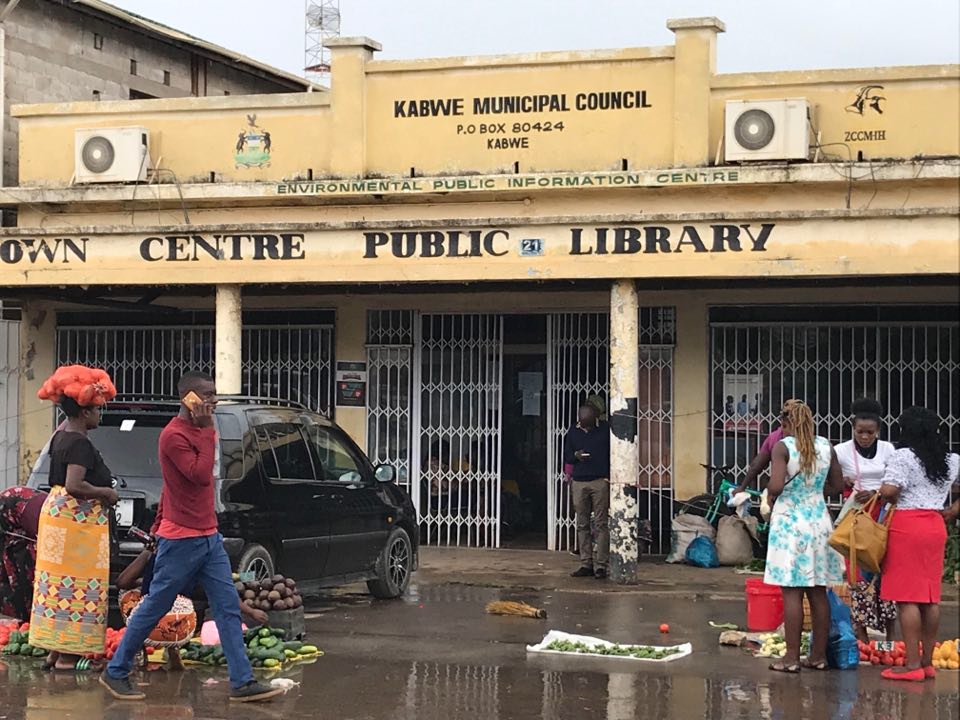- We would appreciate it, if you could kindly donate any books worthy that we can add to our collection in our local library, to help locals benefit …
Contact: Gloria Mushimba
Kabwe Municipal Council Public Libraries Town Centre
Phone: +26 0977 / 0955 975723
e-mail- gloriamushimba@gmail.com
The Nkhanga Library Story
Brief History of the Construction of Nkhanga Library
Dr. Mwizenge Tembo of Zibalwe Village a few kilometers from here was the first person to come up with the idea of building the library. He has been a lecturer or Professor at Bridgewater College in Virginia in the United States of America for the last 22 years. He was visiting his village in June 2006 when at 2 hours or 2:00a min the morning he went outside to use the toilet. He saw a candle light in his nephew Gasione Banda’s hut. The following morning he asked his nephew who was in grade 9 what he was doing at 2:00 hours. His nephew said he was reading his class notes from the teachers instead of reading a book. The nephew Gasione said there were no books anywhere. Dr. Tembo came up with the idea of building a library for the benefit of the community and talked to his younger brother Mr. Vincent Tembo about it. He asked his brother to organize people at Zibalwe and in the villages. They held community meetings.
Headman Limba-Limba gave Dr. Tembo and Mr. Vincent Tembo the land on which to build the Nkhanga library.
It was in August the same year 2006 that Dr. Mwizenge Tembo went back to the United States of America. He told the Bridgewater College community and his American wife Beth Zerweck-Tembo’s family about the library to be constructed at Nkhanga which has Nkhanga Basic school, a clinic, shops, and two churches.
The Americans accepted and were excited about the idea of the project. Mrs. Susan Zerweck, Dr. Tembo’s late mother-in-law made the first donation of K50 million ($10,000.00), Mrs. Sara Shorin, Dr. Tembo’s sister-in-law later donated K125 million ($25,000.00), all the students at Bridgewater College conducted a fundraiser and donated K22.9 million ($4,500.00), and Professor Larry Taylor of Bridgewater College and the Luray United Methodist Church donated K6,240,000.00 ($1200.00). Dozens of individuals and organizations in the United States including small children donated smaller amounts of money toward the library project. Honorable Chifumbu Bamba, Member of Parliament for Nkhanga region made a donation of K400,000.00.
From 2006 to 2012 when the construction of the library was completed, a total of K280 million ($56,000.00) was donated all directly in Dr. Mwizenge S. Tembo’s name because the people trusted he would use the money properly and honestly.
Many private bricklayers and roofers did the construction of the building. Hundreds of bags of cement were used to build the library including over 50 young men did the molding and kilning of over 125,000 bricks. Several tons of crushed stones were hauled from the hills for the foundation.
Read more:
https://zambiaknowledgebank.com/2014/09/the-nkhanga-library-story/
THE HISTORY OF LIBRARIES IN ZAMBIA
The history of libraries in Zambia is linked with the colonial history of the country. Cultural traditions and beliefs of various ethnic groups were preserved through memorv and repeated orally from generation to generation. The changeover from oral traditions to the written word came with the arrival of missionaries who introduced Western education with its emphasis on reading and writing skills. The first missionary to arrive in Zambia, David Livingstone, introduced the first prototype library. Known as the "tin-truck" portable library, it was carried around during his travels in Zambia between 1853 and 1873.
The Livingstone subscription library was one among the first libraries established in Livingstone about 1908; and in the 1920s a number of small subscription libraries were set up in the townships such as Chipata, Kasama, Mongu, Mansa, Lusaka, Luanshya, Choma, and Ndola. Those libraries were used mostly by Europeans who could afford to pay membership and subscription fees.
The British South Africa Company, founded by Cecil Rhodes in 1889, ruled Zambia (then called Northern Rhodesia) until 1924, and did almost nothing to provide and develop library services for the Africans. Similarly, the British colonial government, which ruled Zambia from 1924 to 1964, did not do much either except that some money from its Colonial Development and Welfare Fund was used to establish the Northern Rhodesia Publications Bureau in 1947. The Bureau, renamed joint Publications Bureau of Northern Rhodesia and Nyasaland in 1948, introduced a country book-box library scheme in 1959 that provided the majority of Africans their first access to library services. In 1960 the joint Publications Bureau received a grant-in-aid from the Ford Foundation toward the development of countrywide public library service in Zambia. This grant led to the establishment in 1962 of the Northern Rhodesia Library Service, which was subsequently renamed the Zambia Library Service.
Public library service in Zambia received little government support and suffered from lack of public library legislation. Further contributing factors to disappointing development were unfavorable economic and environmental conditions, resulting in falling prices for exports and rising costs for imports; inadequate transport facilities; unproductive farming; lack of foreign exchange-, and mounting inflation.
Source: http://web.simmons.edu/






















